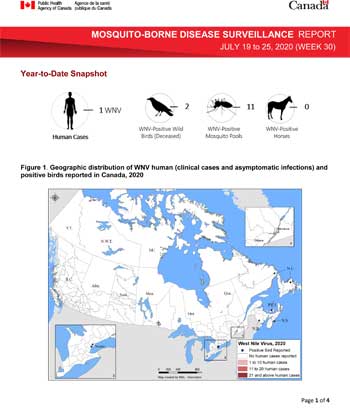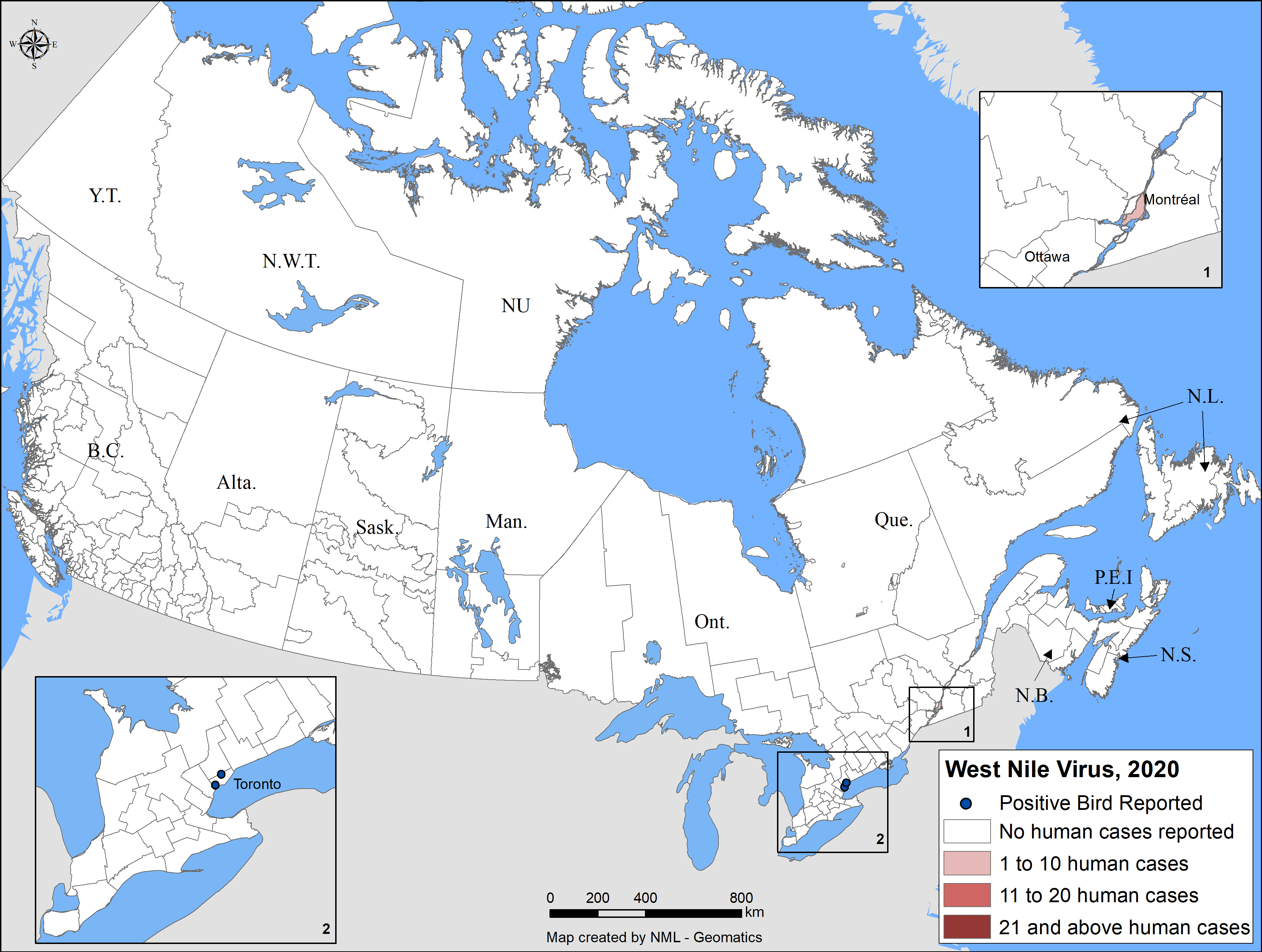Mosquito-borne disease surveillance report: July 19 to 25, 2020 (Week 30)

Download the alternative format
(PDF format, 1.10 Mb, 4 pages)
Organization: Public Health Agency of Canada
Date published: 2020-08-13
Related topics

Year-to-date snapshot - Text equivalent
Between January 1 and July 25, 2020, one human cases of West Nile virus in Canada has been reported to the Public Health Agency of Canada (PHAC). Two WNV-positive birds, and 11 WNV-positive mosquito pools have also been reported.

Figure 1 - Text equivalent
Between January 1 and July 25, 2020, one human case associated with West Nile virus acquired in Canada were reported to PHAC. Two positive birds have also been reported.
West Nile
Human epidemiology
As of surveillance week 30, ending on July 25, 2020, one human case of West Nile virus (WNV) has been reported to the Public Health Agency of Canada (PHAC) (Table 1).
| Province | Clinical cases | Total of clinical cases Footnote 1 | Asymptomatic infections Footnote 2 | YTD grand total | Rate (per 100,000) Footnote 3 | ||
|---|---|---|---|---|---|---|---|
| Neurological | Non-neurological | Unclassified | |||||
| Quebec | 0 | 0 | 0 | 0 | 1 | 1 | 0.01 |
| Total | 0 | 0 | 0 | 0 | 1 | 1 | 0.00 |
|
|||||||
Mosquito, wild bird and equine epidemiology
As of week 30, PHAC has been notified of 7618 mosquito pools tested for WNV in Canada. Of these, there have been 11 WNV-positive mosquito pools identified in Ontario (Table 2).
Two dead wild birds have tested positive for WNV, by the Canadian Wildlife Health Cooperative in Ontario (Table 3).
Since the start of this season, the Canadian Food Inspection Agency (CFIA) has not reported any domestic animals that tested positive for WNV (Table 3).

Figure 2 - Text equivalent
Between January 1 and July 25, 2020, one human case associated with West Nile virus acquired in Canada was reported to PHAC. A total of two birds and <1% of mosquito pools have tested positive for WNV in Canada and reported to PHAC.
Figure 2 footnotes
- Footnote 1
-
Human cases includes clinical cases and asymptomatic infection.
Return to footnote 1 referrer
- Footnote 2
-
Episode week is based on symptom onset or best available date including: diagnosis, lab sample or date reported.
Return to footnote 2 referrer
- Footnote 3
-
Episode week is based off date of death or best available date including: date found, submitted, or received.
Return to footnote 3 referrer
| Province Footnote 1 | Positive pools | Total pools tested | Percent positive |
|---|---|---|---|
| Saskatchewan | 0 | 5 | 0.00 % |
| Manitoba | 0 | 610 | 0.00 % |
| Ontario | 11 | 5368 | < 1 % |
| Québec | 0 | 1635 | 0.00 % |
| Total | 11 | 7618 | < 1 % |
|
|||
| Province | Wild birds Footnote 1 | Equine | ||
|---|---|---|---|---|
| British Columbia | 0 | 0 | ||
| Alberta | 0 | 0 | ||
| Saskatchewan | 0 | 0 | ||
| Manitoba | 0 | 0 | ||
| Ontario | 2 | 0 | ||
| Quebec | 0 | 0 | ||
| Maritime provinces | 0 | 0 | ||
| Territories | 0 | 0 | ||
| Total | 2 | 0 | ||
|
||||
California serogroup
As of July 25, 2020, no human exposures or cases of California serogroup virus have been reported by the National Microbiology Laboratory.
Eastern equine encephalitis
No human cases of EEEV have been reported to PHAC since the beginning of the 2020 transmission season.
The CFIA has not reported any horses testing positive for Eastern Equine Encephalitis virus (EEEV) in Canada.
Provincial/territorial and international surveillance links
Data reported to PHAC is subject to change and may differ from provincial webpages due to reporting timelines. To obtain the latest arbovirus surveillance data, please refer to the following jurisdictional/regional webpages:
Provincial
Notes
Thank you to all our partners for participating in the National WNV/MBD surveillance program.